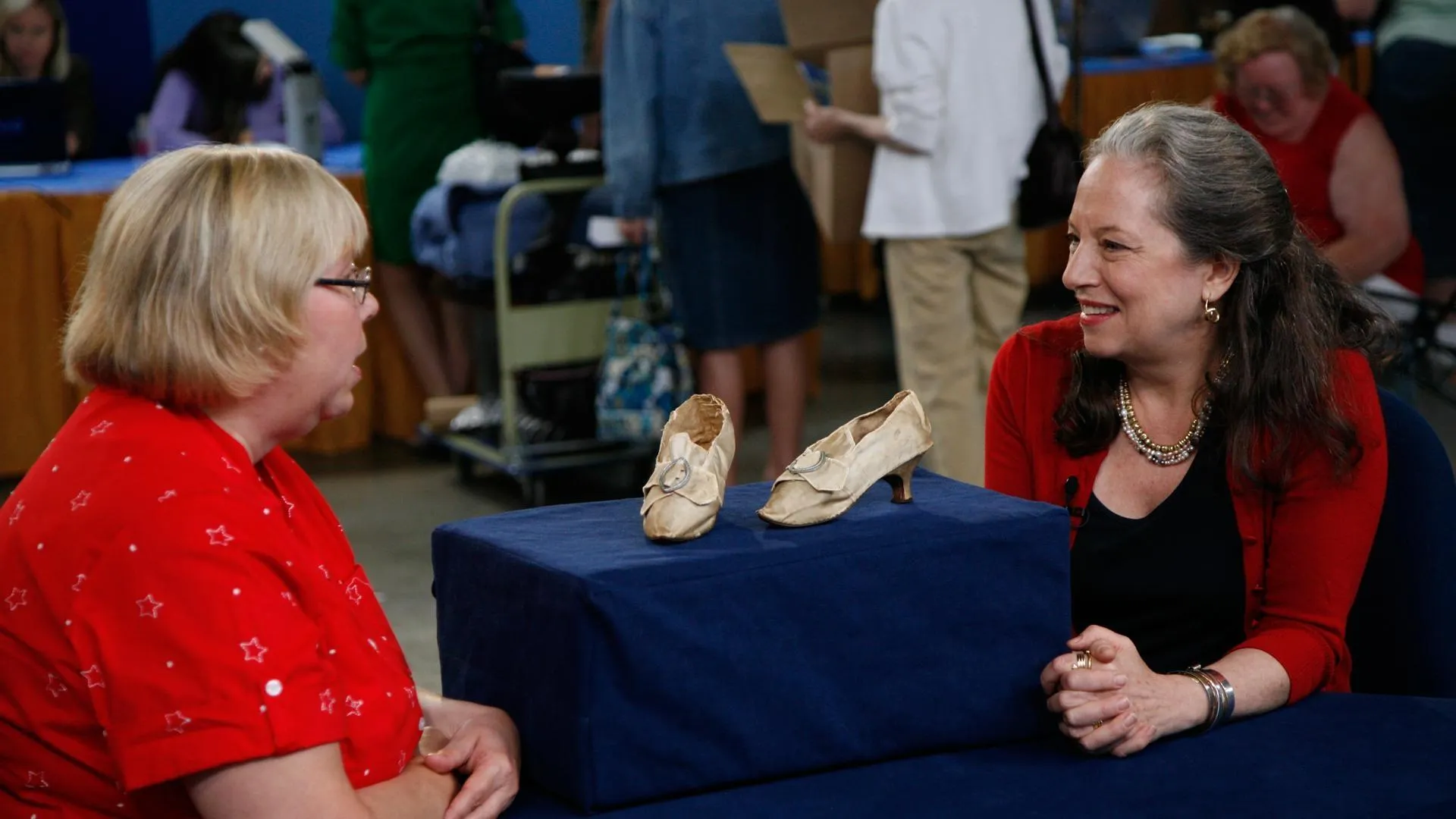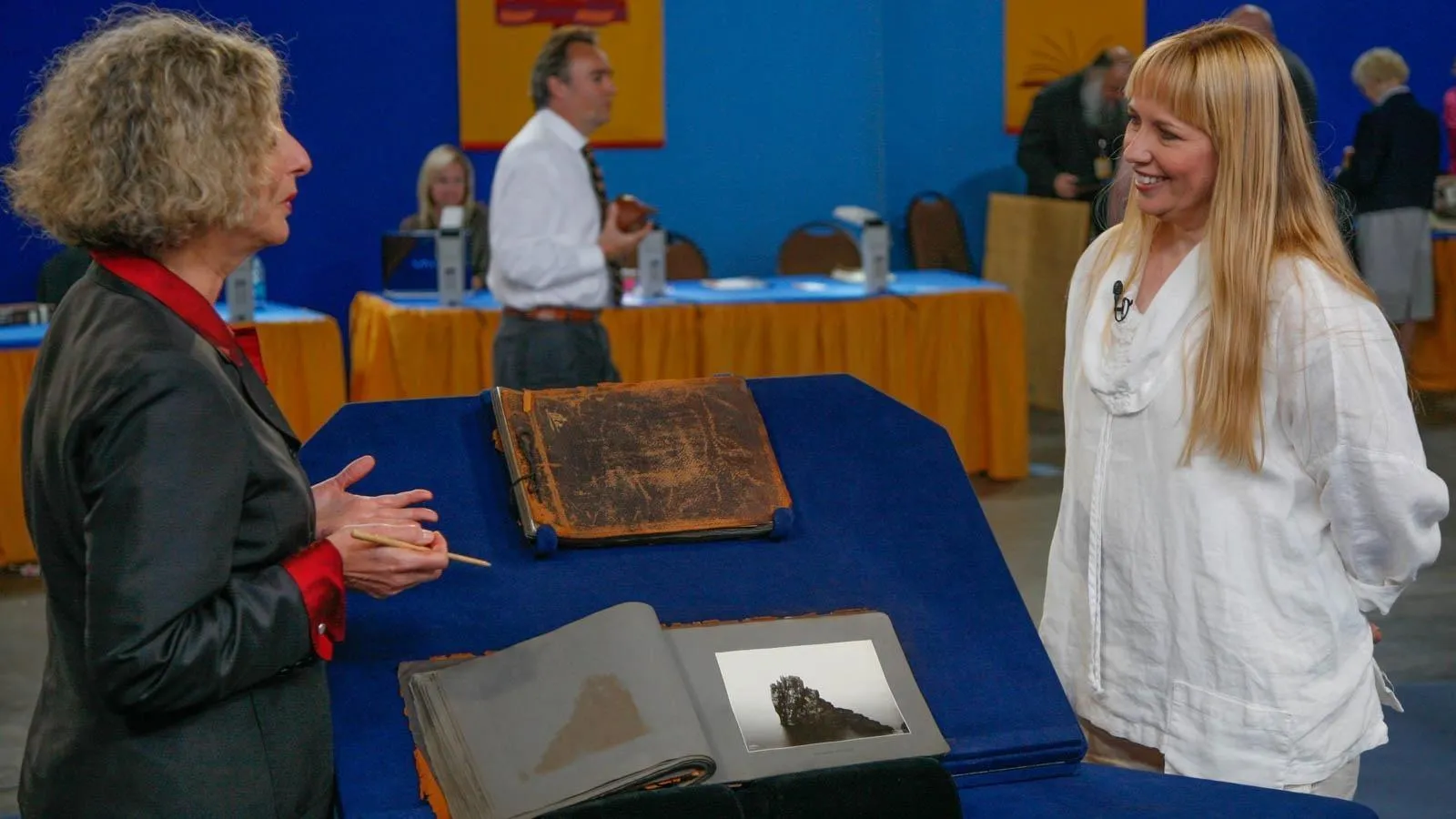GUEST: They're from my mother's family. They've been in our family about 250 years. My mother is from Maine, on the coast of Maine.
APPRAISER: Okay.
GUEST: The story is that they come from Boston. And they've been in our family since the Revolutionary War.
APPRAISER: Okay.
GUEST: I don't know if that's true or not. (laughs)
APPRAISER: Let me tell you about these tables.
GUEST: Okay.
APPRAISER: These tables were made after the Revolutionary War.
GUEST: Okay.
APPRAISER: In about circa 1810. And after the war, America grasped hold of this incredible new style called the Federal style.
GUEST: Mm-hmm.
APPRAISER: It was a reaction, really, against the Chippendale-Rococo style with all the curves and carving. We have these demilune perfect half-circles. Very balanced, everything.
GUEST: Yep.
APPRAISER: These are games tables...
GUEST: Yep.
APPRAISER: ...so this unfolds, as you know, and the leg swings out. And when you weren't using them, you'd put them against the wall and close it up.
GUEST: Yep.
APPRAISER: These oval paterae right there in the front,
GUEST: Mm-hmm.
APPRAISER: typical of Federal, that's beautiful satinwood inlay, tapered legs-- I've never seen this fluted carving. Wonderful detail. Double cross, crossband at feet.
GUEST: Mm-hmm.
APPRAISER: At the bottom, yeah. These tables are probably made in-- based on the construction and the design and this pattern-- this table here with this fluting is typical of Rhode Island, as well as the patera. Now, did you have either of these appraised ever?
GUEST: Um, this table in '94 apprai...
APPRAISER: Okay.
GUEST: …was appraised for $2,000.
APPRAISER: $2,000, okay.
GUEST: Yeah.
APPRAISER: And how about that table?
GUEST: This... no one's ever appraised this table.
APPRAISER: No one's appraised the second table. This got unwrapped first,
GUEST: Right.
APPRAISER: then I looked at the second one. And as the wrapping came off…
GUEST: Yes.
APPRAISER: I saw this inlaid sprig. Now, that is characteristic of a maker named Howard-- Thomas Howard-- who worked in Providence-area Rhode Island.
GUEST: Okay.
APPRAISER: This is a, a Rhode Island table.
GUEST: Okay.
APPRAISER: And this adds quite a bit of interest to the table.
GUEST: Okay.
APPRAISER: I mean, it really does.
GUEST: (laughs)
APPRAISER: Collectors love that little delicate sprig.
GUEST: Yeah.
APPRAISER: Look at the wood, this, again, beautiful quality.
GUEST: Yeah.
APPRAISER: This inlaid edge adds a lot to it.
GUEST: Yeah, that's so beautiful.
APPRAISER: And look at this grungy finish on the top.
GUEST: Right. That's worried me.
APPRAISER: Now, you've never touched it?
GUEST: It's white, and on the in... when you open it up, there's more of this white. And this wood is cracking.
APPRAISER: Okay, looks like some stains here.
GUEST: And that was... Right. Yeah.
APPRAISER: It was used...
GUEST: I don't even… I don't even put furniture polish on it.
APPRAISER: What are these? These are sort of scratches there. Is that...
GUEST: These are... I have a cat that sits on it sometimes to look out the window.
APPRAISER: Oh okay.
GUEST: And whenever I catch her on it, I stop it, I make her get off.
APPRAISER: So she… she scratched them?
GUEST: Yes.
APPRAISER: I hope you never touch them. This is the history of the table.
GUEST: Yeah, yeah the table.
APPRAISER: And it's the original shellac from 1805, right around there.
GUEST: Something, yeah.
APPRAISER: This original finish makes a difference. This table, and the legs are a little bit wider, slightly lower, the proportions, and it doesn't have the sprigs. I would estimate this at $5,000 to $8,000 at auction.
GUEST: Okay.
APPRAISER: Now, this table, because of this incredible wood,
GUEST: Right.
APPRAISER: because of the original finish, because of these sprigs, it makes a big difference.
GUEST: Right.
APPRAISER: It’s… I put an auction estimate of $10,000 to $15,000.
GUEST: Wow, that's fantastic.
APPRAISER: It's an incredible table. They both are.
GUEST: That's fantastic. (chuckles)












